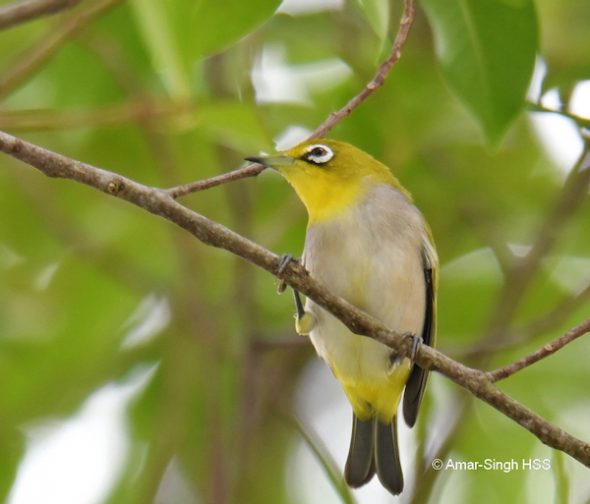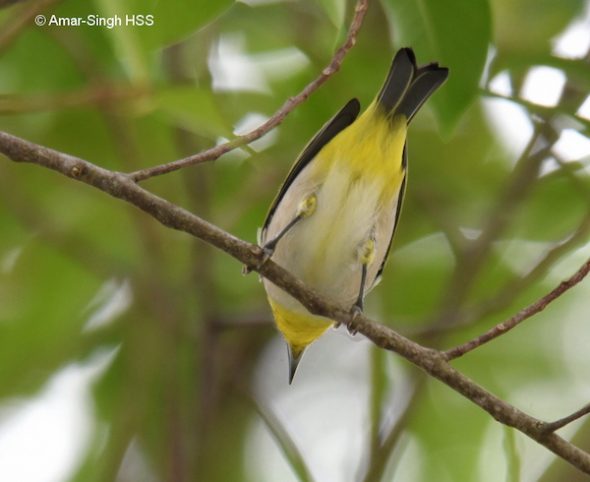I overlooked these White-eyes that I saw but had a closer look and would appreciate any support for ID.
I am very familiar with the Everett’s White-eye (Zosterops everetti tahanensis) and these birds are not Everett’s (now called Hume’s White-eye). I am trying to differentiate between Oriental White-eye (Zosterops palpebrosus auriventer) and Swinhoe’s White-eye or Japanese White-eye (Zosterops japonicus). The added problem is what subspecies? See a discussion by D. R. Wells (2 papers) on ‘Zosterops white-eyes in continental South-East Asia’ in the British Ornithologists’ Club (available online) and an excellent summary by BirdLife International (references). All these recent splits will take time to digest.

Post 1.
Note also that Oriental White-eye (BESG report 2006) and Japanese White-eye (Wells 2007) populations in Singapore are from escaped birds (feral) populations that established breeding populations for decades. I say this as there is very little to separate coastal Johore Bahru from Singapore and birds can cross over easily.

Post 2.
Some key differentiating features from Wells (2007) are summarised in the table.
| Feature | Everett’s White-eye (Zosterops everetti tahanensis)
(should we be calling them Hume’s White-eye?) |
Oriental White-eye (Zosterops palpebrosus auriventer) | Japanese White-eye (Zosterops japonicus) (?subspecies simplex)
(should we be calling them Swinhoe’s White-eye?) |
| Overall | Darker, more green, less yellow | Bright, lime green | More grass green |
| Forehead (frontal band) & above lores | Darker (green), lacks yellow | Yellow | Yellow |
| Median yellow streak on underparts | Runs forwards from belly but does not reach yellow of upper breast | Lacks median yellow stripe |

Post 3.
These 5-6 birds I saw (Post 1-3) have a yellow frontal band and yellow above the lores and lack a decent median yellow stripe (very faint one in some birds). Hence I am inclined to think they are Swinhoe’s White-eye – formerly thought to be Japanese White-eye complex but recently genetic work shows that many of these birds in Singapore originate from mainland Asia (China, Taiwan, Vietnam) (Lim et al 2019).
Swinhoe’s White-eyes are not listed in the ‘Checklist of the birds of Malaysia Dec 2016, v2’. The location I saw these birds is just near the causeway to Singapore.
References:
- Wells, D.R. (2007) The birds of the Thai-Malay Peninsula: Vol. 2 (Passarines). Christopher Helm, London.
- Wells, D.R. (2017a) Zosterops white-eyes in continental South-East Asia. 1: proposed refinements to the regional definition of Oriental White-eye Z. palpebrosus. Bulletin of the British Ornithologists’ Club 137(2): 100-110.
- Wells, D. R. (2017b) Zosterops white-eyes in continental South-East Asia. 2: what is Zosterops auriventer Hume? Bulletin of the British Ornithologists’ Club 137(2): 110-116
- BirdLife International. Archived 2019 topic: A re-evaluation of the species limits in Asian white-eyes Zosterops https://globally-threatened-bird-forums.birdlife.org/2019/05/a-re-evaluation-of-the-species-limits-in-asian-white-eyes-zosterops-implications-and-an-appeal-for-information-to-assess-the-status-of-the-newly- recognised-sangkar-white-eye-z-melanurus/
- Bryan T. M. Lim, Keren R. Sadanandan, Caroline Dingle, Yu Yan Leung, Dewi M. Prawiradilaga, Mohammad Irham, Hidayat Ashari, Jessica G. H. Lee, Frank E. Rheindt. (2019) Journal of Ornithology, Volume 160, Issue 1, pp 1–16
Amar-Singh HSS (Dato’ Dr) – Ipoh, Perak, Malaysia
Location: Johore Bahru, Johore, Malaysia
Habitat: City garden very near the coast to Singapore
Date: 29th October 2018
Equipment: Nikon D500 SLR with Tamron SP 150-600mm f/5-6.3 Di VC USD, handheld









2 Responses
Dear BESG / Dato’ Dr Amar
I have recently the pleasure of observing (and taking a few passable pictures) of a small flock of white-eyes, at northern Klang Valley town of Gamuda Gardens, Rawang, Selangor. The ones which I observed have the yellow frontal band and yellow above-lores, and also a clear ventral yellow stripe which does not quite reach the yellow of the throat.
Unfortunately I cannot decipher a lot of the technical information in Bryan et al (2019), and Wells (2017a, 2017b), so efforts at identification are limited using information from bird blogs. Apparently the Swinhoe’s (Z. simplex) have a more prominent eye-ring (half the diameter of the eye) compared to the Hume’s (Z. auriventer), which eye-ring is one-third the diameter of the eye (BirdTour Asia Facebook page, 2020). Also, apparently, there is a subspecies of Z. simplex that does not have the median stripe, which supposedly is the northern, migratory population) (BirdTour Asia Facebook page, 2020). What is more perplexing is that in Bryan et al (2019), auriventer is not one of the five proposed species (the five being palpebrosus, simplex, melanurus, citrinella and japonicus).
Therefore, I suspect that my observed white-eyes are probably Z. simplex due to the very prominent eye-ring, frontal yellow lores, and the ventral stripe (which marks it as a local population). Of course, comments/suggestions are greatly welcomed.
Thank you.
Dear Di Lin,
Can you share your photo of the white-eyes Z. simplex taken at Gamuda Gardens, Rawang, Selangor?